Fishery
production in Eastern Visayas declines by 2.9% in 2017
By
PSA-8
March 28, 2018
TACLOBAN CITY –
Fishery production in Eastern Visayas decreased by 2.9% from 140,275
metric tons (MT) in 2016 to 136,141 MT in 2017.
All provinces registered
decreases in fishery production, except Leyte, the only province
that recorded a significant increase of 24.8%, from 37,163 MT in
2016 to 46,361 MT in 2017. Southern Leyte recorded the highest
decrease by 20.0%, from 7,006 MT in 2016 to 5,605 MT in 2017.
Among provinces, Leyte
produced the highest volume of fisheries at 46,361 MT which
comprised 34.1% of the total fishery production in the region. Samar
ranked second with 35,809 MT which accounted for 26.3% of the
region’s total fishery production. Southern Leyte, meanwhile
registered the lowest volume of production with 4.1% share or 5,605
MT.
By subsector, volume of
production in Commercial Fishing went down by 43.1%, from 24,613 MT
in 2016 to 13,995 MT in 2017. All provinces registered decreases
with Leyte recording the largest drop in volume of production at
69.3%.
Volume of production in
Municipal Fishing (marine and inland) also registered a decrease of
5.2%, from 83,443 MT in 2016 to 79,107 MT in 2017. All provinces
registered decreases except for Biliran and Leyte which posted an
increase of 10.6% and 1.2%, respectively. Samar registered the
highest decrease in volume of production at 8.8%.
On the other hand, volume
of production in Aquaculture went up by 33.6%, from 32,219 MT in
2016 to 43,039 in 2017. Increases registered in Southern Leyte
(68.8%), Leyte (58.1%), and Eastern Samar (31.7%) offset the
decreases recorded in Biliran (97.2%), Samar (14.0%), and Northern
Samar (10.8%).
Almost three-fifths or
58.1% (79,107 MT) of the total fishery production in the region were
from Municipal Fishing. Aquaculture contributed 31.6% (43,039 MT),
while Commercial Fishing accounted for 10.3% (13,995 MT).
|
Volume of Fishery Production by sub-sector and province, Region VIII: 2016-2017
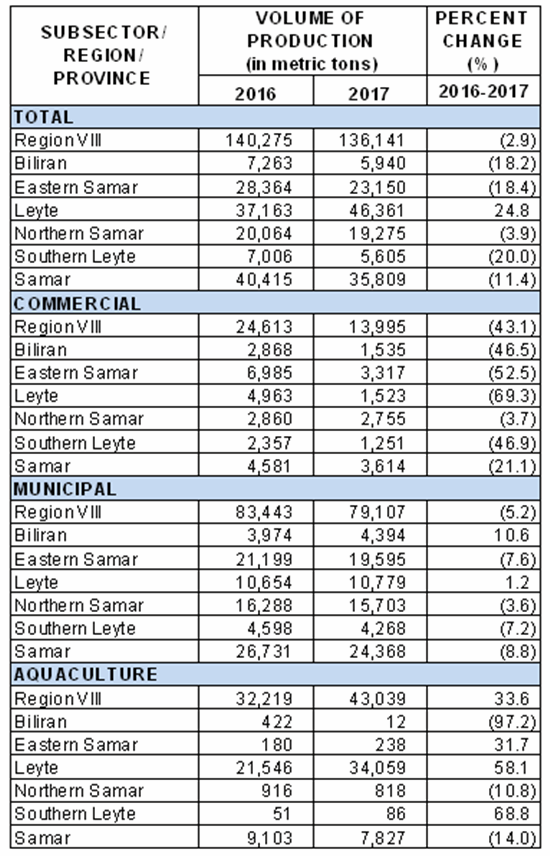 |
|
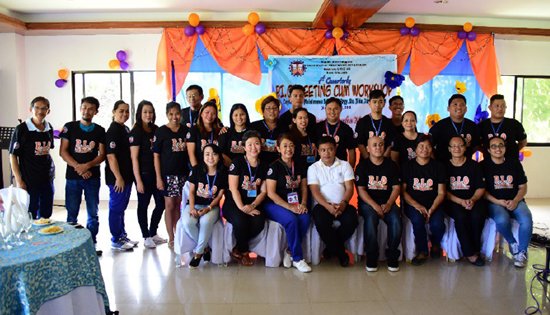
DPWH
Public Information Officers are all smiles at the end of the
workshop posing with the resource speaker Mr. Sarwell Q.
Meniano (wearing white polo shirt). |
DPWH-8 PIOs hold
workshop on press release that lands a media coverage
Press Release
March 28, 2018
NAVAL, Biliran –
Public Information Officers (PIOs) of the Department of Public Works
and Highways (DPWH) Region VIII continuously exert efforts to
enhance their news writing skills.
Recently, DPWH PIOs held
their first Quarterly Meeting Cum Workshop at Leyte 1st District
Engineering Office (DEO) Maintenance Sub Office, Brgy. Sto. Niño,
Tanauan Leyte on March 22-23 with the topic ‘’Press Release (PR)
That Lands a Media Coverage’’.
With different career
background among DPWH PIOs, Ms. Antonieta R. Lim, DPWH Regional PIO
said that conducting workshops under the department’s Communication
Development Program will improve the capacity of the designated
district PIOs on their duties and responsibilities to inform the
public of its programs, policies and projects.
There were at least 30
PIOs from 13 district engineering offices attended the said workshop
with Mr. Sarwell Q. Meniano as the resource speaker.
Meniano is currently the
editor of Philippine News Agency in Eastern Visayas Region.
One of the highlights of
his discussion is sharing the most common mistakes in PR writing.
According to him, there is only 2.6 seconds to win over a visitor.
Having a wrong headline is a total waste while good headlines makes
a difference.
The best clock worthy
headlines according to him is dealing with statistics. From the
planning stage, design, construction and maintenance of national
infrastructures, DPWH deals with statistics every day. He gave
advice to focus more on the project updates, number of kilometres,
number of beneficiaries and the like.
Aside from writing a good
headline, Meniano also encouraged the participants to use active
voice in their news writing instead of the passive voice because it
is shorter and more direct.
He also shared the most
common mistakes in DPWH press releases. Among of these are having
the very long start, too many names in news lead, too many technical
terms, overuse of unfamiliar acronyms, less attention to the
substance, no direct quotations and more.
“PRs that doesn’t require
much correction from the editor have a bigger chance on landing a
media coverage since it would not cost much time for the editor to
edit,” said Meniano.
To test the learnings of
the participants, they were tasked to re-write and identify mistakes
from the sample news release given by the resource speaker. The
activity gave the participants a better understanding on writing a
good PR.
The workshop ended with an
open forum from the participants followed by the 1st quarterly
meeting of PIOs.
DPWH PIOs will continue to
conduct trainings and seminars under the Communication Development
Program to acquire and develop their communication skills.
|
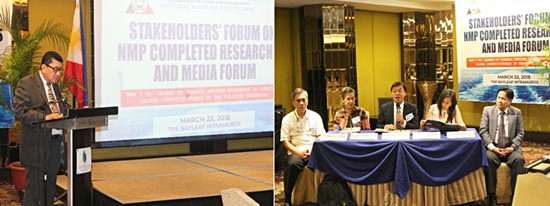
Left
picture: Usec. Jacinto V. Paras delivering his Keynote
Speech. Right picture: NMP Key officials answering the
questions posed by the media. |
NMP conducts
stakeholders’ forum and media forum
Press Release
March 28, 2018
TACLOBAN CITY – As
part of the Agency’s commitment to improve the maritime industry,
the National Maritime Polytechnic (NMP) thru its Maritime Research
and Development Division (MRDD) conducted a Stakeholders’ Forum and
Media Forum on 22 March 2018 at The Bayleaf Intramuros, Manila.
The Stakeholders’ Forum served as a venue for NMP to present the
three (3) completed researches in CY 2017, namely: Skills Gaps
Analysis of Maritime Faculty in Philippine Maritime Higher Education
Institutions (MHEIs); Gender Sensitivity Training for Seafarers (GSTS)
Course: A Program Evaluation; and Responding to the Filipino
Seafarers’ Training Requirements in the STCW 2010 Manila Amendments:
Challenges and Opportunities.
Usec. Jacinto V. Paras quoted during his keynote speech an African
proverb that says, “If you want to go fast, go alone; but if you
want to go far, go with others.” He said that “Going far simply
can’t be done without people to support you.” He emphasized the need
to sustain cooperation and collaboration between and among maritime
stakeholdersto be able to respond to the ever growing needs of the
Filipino seafarers.
Findings of the researches were disseminated to the industry
stakeholders from the government, maritime education and training
(MET) institutions, maritime associations, seafarers’ organizations,
shipping companies and manning agencies. Recommendations from the
researches may serve as valuable inputs to policy making and program
development that impact on the Filipino seafarers as a special
workforce of the country.
The forum also served as a platform for NMP to launch its e-Research
Information System which was developed to communicate to the public
its conducted researches, engage interested stakeholders to
collaborate in ongoing research undertakings, solicit researchable
areas, enjoin the MET practitioners to contribute papers and
articles for the Philippine Journal on Maritime Education and
Training (PJMET) and facilitate linkages between and among
stakeholders and concerned maritime agencies both for the private
and the government entity.
Along with the Philippine Development Plan of the Duterte
Administration, the NMP crafted its Strategic Plan 2018-2020 within
its mandate and towards its vision as “The Philippines’ leader in
maritime training, including e-learning and research”. The said plan
was also presented during the forum for further inputs from the
stakeholders as a way of validating its responsiveness to the
industry that the NMP serves as well as to introduce possible areas
of collaboration in the implementation of the plan.
The conduct of research is one of the mandates of NMP, in which
research output are utilized to formulate policies and regulations
for the improvement of the maritime manpower sector of the industry.
NMP is also mandated to conduct researches on the latest maritime
technology.
In the afternoon of the said day, a Media Forum was organized by NMP
to communicate to the national media the highlights of
accomplishments of the Agency, strategic directions and major
programs, projects and activities towards its vision and mission.
There were forty-nine (49) participants to the stakeholders’ forum
while the media forum was attended by twenty (20) media outlets
mostly members of Maritime Journalists Association of the
Philippines (MJAP), Inc., headed by Ms. Carmela I. Huelar, its
President.
Aside from its research function, the NMP continues to upgrade its
facilities and provide maritime trainings required pursuant to the
Standards of Training, Certification, and Watch keeping for
Seafarers (STCW) Convention as amended in 2010 including
value-adding courses towards improving the qualifications of
Filipino seafarers for their employment acceptability and enhanced
competitiveness.
Those interested to take NMP training programs may visit the NMP
website www.nmp.gov.ph and its Facebook page (www.facebook.com/nmptrainingcenter)
where all related information on NMP trainings are available.
Highlights of
Eastern Visayas’ construction statistics: 4th quarter 2017
By
PSA-8
March 28, 2018
TACLOBAN CITY – The
region’s total number of constructions in the fourth quarter of 2017
reached 669. This reflected a decrease of 56.5% from the 1,539
constructions recorded during the same quarter in 2016.
Data were based on the
preliminary results of construction statistics from approved
building permits.
 By type of construction,
Residential Building constructions declined by 72.8%, from 1,248
constructions in the fourth quarter of 2016 to 339 constructions in
the fourth quarter of 2017.
By type of construction,
Residential Building constructions declined by 72.8%, from 1,248
constructions in the fourth quarter of 2016 to 339 constructions in
the fourth quarter of 2017.
On the other hand,
Non-Residential Building constructions increased by 12.2%, from 181
constructions in the fourth quarter of 2016 to 203 constructions in
the same period of the 2017.
Similarly, combined number
for Additions/Alterations and Repairs of existing structures went up
by 15.5%, from 110 constructions in the fourth quarter of 2016 to
127 constructions during the quarter in review.
A little more than half
(50.7%) of the constructions were Residential Buildings.
Non-Residential Buildings comprised 30.3%, while
Additions/Alterations and Repairs accounted for 19.0% of the
region’s total constructions.
The total value of
constructions in the region during the fourth quarter of 2017 was
estimated at P1.9 billion. This figure is 36.1% lower compared with
the P3.0 billion total value of constructions during the same
quarter in 2016.
Total value of Residential
Building constructions significantly dropped by 76.6%, from P1.9
billion in the fourth quarter of 2016 to P4.4 million in the same
period in 2017.
Similarly, aggregate value
of Additions/Alterations and Repairs declined by 34.5%, from P87.9
million in the fourth quarter of 2016 to P57.5 million in the fourth
quarter of 2017.
On the other hand, total
value of Non-Residential Buildings increased by 34.9%, from P1.1
billion in the fourth quarter of 2016 to P1.4 billion during the
quarter in review.
Total value of
Non-Residential Building in the region comprised the largest share
in terms of value at 74.4%. Value of constructions of Residential
Building contributed almost a quarter (22.7%), while
Additions/Alterations and Repairs accounted for 3.0% of the region’s
total value of construction.
Average cost per square
meter of residential buildings
Average cost per square
meter of Residential Buildings in the region for the fourth quarter
of 2017 was estimated at P8,811, higher by 3.1% compared with the
P8,544 average cost in the same period last year.
 Among the different types
of residential buildings, Single type reported higher average cost
per square meter at P8,639 during the reference period from P7,740
per square meter in the same period in 2016.
Among the different types
of residential buildings, Single type reported higher average cost
per square meter at P8,639 during the reference period from P7,740
per square meter in the same period in 2016.
Similarly, average cost
per square meter for Apartment/Accessoria/Others increased by 12.6%,
from P8,761 in the fourth quarter of 2016 to P9,868 in the same
quarter in 2017. It reported the highest average cost per square
meter among residential buildings.
On the other hand, average
cost of Duplex/Quadruplex decreased by 19.1%, from P10,089 in the
fourth quarter of 2016 to P8,167 during the quarter in review.
Average cost per square
meter of non-residential buildings
Average cost per square
meter of Non-Residential Buildings in the region for the fourth
quarter of 2017 was estimated at P7,237, lower by 18.7% compared
with the P8,903 average cost in the same period last year.
Among the different types
of non-residential buildings, Commercial Buildings reported lower
average cost per square meter at P6,867 during the reference period
from P8,681 per square meter in the same period in 2016.
Similarly, average cost
per square meter for Institutional Buildings decreased by 31.0%,
from P10,556 in the fourth quarter of 2016 to P7,286 in the same
quarter in 2017.
On the other hand, average
cost of Agricultural and Other Non-Residential Buildings more than
doubled, posting an increase of 114.0%, from P4,155 in the fourth
quarter of 2016 to P8,891 in the fourth quarter of 2017. It reported
the highest average cost per square meter among non-residential
buildings.
Industrial Buildings
likewise recorded higher average cost per square meter at P7,018
during the quarter in review from P4,992 per square meter in the
same period in 2016.
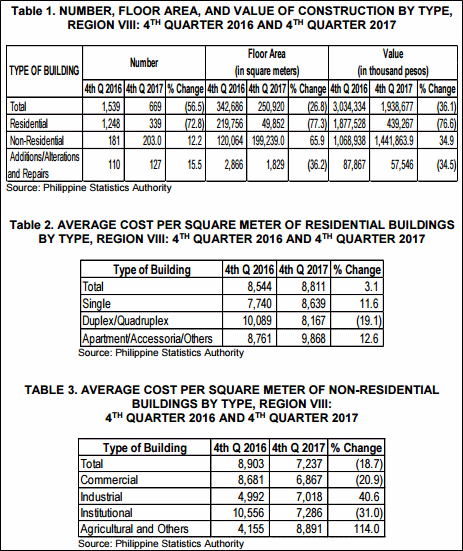
|
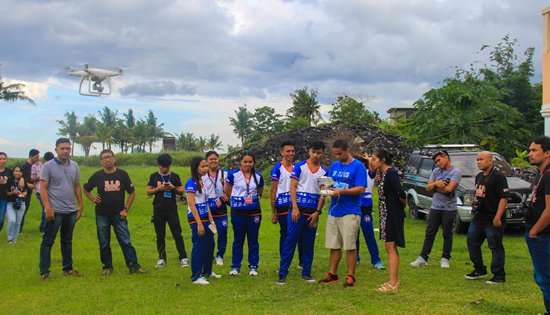
Glenn
Lagman (in blue shirt and khaki shorts) of Samar First
District Engineering Office gets a first-hand experience in
handling drone operation. |
DPWH: Public
Information Officers take training to new heights
By
BON JOSEPH N. ASTILLA
March 27, 2018
CALBAYOG CITY –
Public Information Officers (PIOs) of the Department of Public Works
and Highways (DPWH) Region VIII upgrade their skills during the
first quarterly meeting on March 22-23, 2018 in Tanauan, Leyte.
Hosted by the joint efforts of Leyte I, II, III District Engineering
Offices and Tacloban City District Engineering Office, the meeting
cum workshop tackles drone operation among many others.
The technical name of
drones is “Unmanned Aerial Vehicles” (UAVs). They are trending
aerial vehicles which come in wide varieties of sizes and shapes and
functions, which are controlled either by remote or control systems
from the ground. The PIOs take advantage of such device to further
up their game in the field of documentation as well as make use of
it in audio-visual presentations. In the workshop, PIOs get to have
basic knowledge of the tool and equal opportunities in actual flying
it to film and capture pictures in high altitude.
Information accumulated
though will be wasted if not properly disseminated by appropriate
means. This is where improving media relations come into play which
is the topic of the resource speaker, Mr. Sarwell Q. Meniano, an
editor in the Philippines News Agency. He provided pointers in
making press releases that will land media coverage as well as
steadily trekking the tricky and fragile relationships with the
media. Ms. Antonieta R. Lim, Regional Public Assistance and
Information Officer, and her staff added some updates with the
Communication Development Program in line with the continuing
capability-building effort for PIO designates and it’s alternate.
The training culminates
with Mr. Sarwell Q. Meniano leaving a reminder, “Never assume that
others know what you know. Submitting a story online means you are
reaching to a global audience who are not familiar with local and
technical terms. Think global in this digital age.”
Army clashes anew
in Eastern Samar, 1 CPP-NPA terrorist killed, 2 high powered
firearms recovered
By
DPAO, 8ID PA
March 27, 2018
CAMP LUKBAN, Catbalogan
City – A platoon from 14th Infantry (Avenger) Battalion under
Lt. Col. Manuel Leo Q. Gador while responding to information from
the populace on the presence of an armed group in Barangay San Roque,
Maslog, Eastern, Samar was fired upon by more or less 12 CPP-NPA
Terrrorists (CNTs) today, March 27, 2018 at 6:00 o’ clock in the
morning.
The 30-minute firefight
resulted to the recovery of one M16A1 rifle; one AK-47 rifle; one
hand grenade; two landmines; 11 jungle hammock backpacks; 12 poncho
tent; one cellular phone; and subversive documents with high
intelligence value. No reported casualty on the government side
while one dead body of the enemy was recovered at the encounter
site.
This unrelenting campaign
of the Army in the region will deter the criminal activities of the
CNTs to conduct possible attack/atrocities on far-flung communities
during the observance of the Lenten Season.
In his message, Maj. Gen.
Raul M. Farnacio AFP, Commander, 8ID said, “These CPP-NPA Terrorists
are taking advantage from the shadow of fear and weakness of the
community of their threat, we will not put our hands down in
securing the safety and protection of community.”
Renewable energy
advocates, citizen’s groups decry Congress’s recommendation for
Meralco’s ‘dirty, costly’ contracts
Press Release
March 27, 2018
QUEZON CITY – Civil
society organizations slammed the recent recommendation issued by
the House of Representatives Committees on Energy and Good
Governance and Public Accountability supporting the approval of
Meralco’s controversial deals with its affiliate generation
companies.
“After almost a year of
investigating the irregularities surrounding Meralco’s seven Power
Supply Agreements (PSAs) with its sister generation corporations,
the House of Representatives Committee on Energy ended up
recommending the approval of the questionable contracts,” said
Center for Energy, Ecology, and Development (CEED) Executive
Director Gerry Arances. “This goes against the facts and evidence
presented by civil society, affirmed by the Ombudsman’s finding of
possible collusion between Meralco and the ERC,” he continued.
Quezon Representative
Cong. Danilo Suarez filed the motion to recommend the contracts for
approval after Bayan Representative Cong. Zarate moved to
investigate the anomalous deals entered into by Meralco without the
required competitive selection process (CSP), suspiciously waived by
the ERC for the distribution utility.
“CEED has twice presented
in the hearings conducted by the Committees on Good Governance and
Energy the effect of approving these contracts on the environment,
the electricity bills of consumers, and the country’s commitment to
abandon coal and increase the share of Renewable Energy,” said CEED
Legal Officer Atty. Avril De Torres. “While the decision to approve
these contracts lie solely on the ERC, the recommendation of the
House of Representatives may overshadow the various irregularities
surrounding the deals, and their negative implications on the
consumers,” she continued.
De Torres reiterated how
these PSAs accounting for 3,551 MW of power will “lock in millions
of Filipinos to relying on costly and dirty energy from coal for at
least twenty years” once approved.
“The opportunity cost of
losing the interest of coal investors is not enough to subject the
end-users to such an unfair deal,” De Torres responded to Rep.
Suarez’s comments. “The resolution disregards the willingness of
clean energy companies to fill in the energy needs of the consumers
while respecting the governing rules ensuring that consumers will be
provided the cleanest, most competitive energy option,” De Torres
continued.
Atty. Aaron Pedrosa of the
multisectoral coalition Sanlakas, among the oppositors in the
applications filed by Meralco and its affiliate coal companies,
denounced how Meralco has successfully mobilized support from almost
all branches of the government, even with its “blatant disregard for
good governance and the rights of the consumers.”
“From the TRO by the Court
of Appeals lifting the suspension of the seven ERC commissioners
suspected of colluding with Meralco, to the Lower House’s
recommendation of Meralco’s power deals, the country’s largest power
company has successfully maneuvered to getting its way at the
expense of Filipino citizens,” said Pedrosa. “On top of that, it is
using fear tactics to scare consumers into thinking that the
rejection of their contracts will lead to massive brownouts, which
the House of Representatives reflected in their resolution,” he
said.
“The recommendation issued
by the Lower House is also a slap in the face of those who will be
affected by and are actively resisting the construction and
operation of coal fired power plants, most notably those in Atimonan,
Quezon, the very constituents of the recommendation’s mastermind,
Rep. Danilo Suarez,” Pedrosa noted.